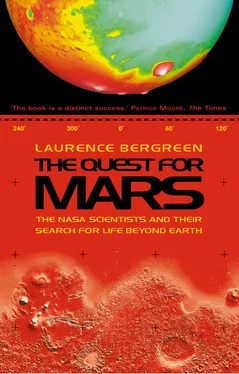In late October, the engineers at KSC mated the spacecraft with the cruise stage of the Delta rocket, and loaded fuel into the spacecraft’s propulsion system. It was powered by hydrazine, nasty stuff that requires careful handling. If you touch hydrazine, it can burn your skin. If you spill it, it can start a fire. The engineers wore protective suits very much like an astronaut’s while they worked. In this instance, the fueling process proceeded safely. Soon after, technicians tested the Deep Space Network, the system for communicating with Pathfinder. The DSN consists of three ground stations – one in Goldstone, California, another in Madrid, Spain, and a third in Canberra, Australia. Exquisitely sensitive, the DSN can pick up exceptionally faint signals from spacecraft as far away as Jupiter, and possibly beyond the boundaries of the Solar System. In November, the team started holding practice countdowns. The launch was approaching rapidly; now it was days, not weeks away. Back at JPL in Pasadena, a sign read, “OBJECTS ON THE CALENDAR ARE CLOSER THAN THEY APPEAR.” It was a message that everyone on the Pathfinder team had learned to heed.
The closing of the spacecraft, supposedly a modest episode in the life of Pathfinder, inflated into a media event. Dan Goldin, the NASA Administrator, showed up at the Kennedy Space Center and gave a rousing speech. Crowds turned out to watch Pathfinder’s four petals fold shut around the rover. As everyone applauded, the engineers glimpsed a sliver of daylight between the petals. This was not a good omen: to close a spacecraft in preparation for launch, only to find that the pieces don’t fit. The event had been scheduled for television broadcast, but the engineers waved away the cameras so they could study the problem. This was the first time the spacecraft had been fully loaded, and the increased weight created structural sagging, which kept the petals from sealing as designed. During the next several days, engineers worked desperately to repair the problem, and couriers bearing modified parts flew in from JPL. “objects on the calendar are closer than they appear.” One by one the new parts were mated, and the entire assembly was stacked on to the launch vehicle, and trucked over to Launch Pad 17A at Cape Canaveral Air Station.
The launch was scheduled for December 2, and it proved to be an exercise in frustration. “The weather was so bad they decided to cancel the attempt for the day,” Donna Shirley wrote in her field journal. “On December 3, many of us went out to the launch pad to watch the gantry roll back. This was supposed to happen at 5 PM but didn’t actually occur until 7:30 PM. It got colder and colder, and there was a prelaunch party scheduled. A few diehards, including me, were all that were left to see the rocket standing free of the supporting structure. It was worth waiting for, shining in the spotlights, gleaming blue and white.” For a few hours that night, the countdown proceeded smoothly, but problems started to mount. “First, the winds aloft looked bad,” Donna recorded. “The range sent up balloon after balloon to see what the winds were like, and gradually they began to improve. By the fourth balloon they looked acceptable, and we all began to get excited. But there was another problem. One of the ground computers was having problems. After much discussion, the launch vehicle team decided to change to a backup computer. But about two minutes before launch time, that computer also had trouble, and the launch was scrubbed. Everyone sagged. We’d been running on adrenalin, not a bit sleepy, but once there was no launch everyone went home to bed.” Bridget Landry, a Pathfinder software engineer who’d been following the tortured countdown from Pasadena, also turned to her journal for consolation: “We were all so disappointed when they said we had to scrub! All that anticipation! In some ways, it’s funny, all that buildup, and then nothing happens. But it’s also scary: the Russian mission, Mars ’96, was unable to escape Earth’s gravity just a few weeks ago. Somehow, that makes us worry more about our launch. Guess scientists and engineers can be a little superstitious, just like anyone else.”
On December 4, with all conditions favorable, Pathfinder finally launched from Cape Canaveral at 1:58 AM, local time. Although the blast was visible in the night sky for miles, there were no throngs along the beach. The event was the merest blip on the news radar; the public remained mostly oblivious to the fact that we were returning to Mars. Pathfinder was just another planetary mission, for the time being.
After launch, the engineers at JPL had a rough idea where Pathfinder was located in space, but now they needed to know precisely where it was. To get a better fix on the spacecraft, they planned to establish contact with it through the Deep Space Network. But before they could do that, the spacecraft was supposed to orient itself with a device called a sun sensor, a small disc covered with photoelectric cells. The event was supposed to occur about ninety minutes after the launch, with the spacecraft traveling at 17,000 miles an hour, but the sensor wasn’t working properly, and if it failed, they would soon lose the spacecraft entirely. As everyone involved with the mission knew, if Pathfinder failed, the future of the entire Mars program, including a human mission, would be in grave doubt.
After extensive searches, the Goldstone, California, antenna of the Deep Space Network finally acquired a signal from Pathfinder, which confirmed that something was seriously wrong with the spacecraft: the sun sensor wasn’t returning data. The best guess was that the sensor’s photoelectric cells had been nearly blinded by exhaust from one of the launch rockets, and Pathfinder refused to pay attention to it. The fix was simple, in theory: send three new software files to command Pathfinder to tune into the sensor. The engineers transmitted the files again and again, but each time they were only partially received, and no one could say why. The situation, already very serious, deteriorated when the spacecraft began to ignore all commands. Eventually, one of the engineers realized that Pathfinder was revolving slowly and came in position to receive commands for only five seconds at a time. Now Pathfinder had two problems – the dirty sensor and the uncontrollable spinning. The double fault was likely to be fatal to the entire mission.
Working around the clock, the Pathfinder engineers compensated for the rotation, and transmitted a complete set of commands to the spacecraft. Once they did, Pathfinder paid attention to the sun sensor, oriented itself properly, and both problems disappeared. The process of resolving them, collaborative and critical, proved to be a rite of passage for the Pathfinder team. Although they were relieved to have fixed a problem that could have killed the mission, they knew that more could appear at any time. Pathfinder was single-string all the way; if a component failed, there was no backup.
In the ensuing days, a weird sense of calm descended on JPL. There wasn’t much anyone could do for the next ten months besides monitor the spacecraft, whose instruments were powered down for the long cruise. “I’ve always known that the spirit on Pathfinder was special,” Bridget Landry noted in her journal, “but when the people who worked on Apollo 11 and 13 say this project has more sense of identity and team spirit than even those two missions, you know you’re involved with something extraordinary. But the feeling here, at least for me, is bittersweet, too. Now that we’ve launched, some people are being laid off, and even though most of us are staying, the scope of the mission means that in less than a year, all this will be over.”
In the spring of 1997, as the spacecraft approached Mars, the Pathfinder team began a new series of tests to prepare for its prime mission – the weeks Pathfinder would spend on the Red Planet, roving and returning data. “Think of it as a rehearsal,” Bridget Landry’s journal explained. “We have a computer that simulates the spacecraft, as well as a model of the lander and a duplicate rover. We put the last two in our sandbox (a room full of sand and rocks used to simulate the surface of Mars), then close the curtains so that no one can see in, and a few people go in and rearrange the rocks. Then the operations team has to take pictures with the lander camera, determine where the rocks are, and generally do all the tasks we’ll do on the first two days on Mars.”
Читать дальше












